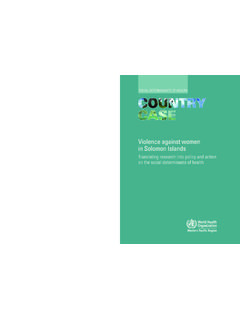Transcription of Family and domestic violence perpetrator …
1 Family and domestic violence perpetrator programsIssues paper of current and emerging trends, developments and expectationsRodney Vlais, Sophie Ridley, Damian Green and Donna ChungStopping Family violence Inc. 2017 Page 1 of 133 Contents Executive Summary .. 4 Introduction .. 7 perpetrator intervention systems .. 8 Work with perpetrators from Indigenous communities .. 10 Who this issues paper is for .. 11 A note on terminology .. 11 The philosophical context .. 12 Points of contention .. 12 Social movement or individual treatment.
2 12 Social education or therapy .. 13 Part of or alternative to the criminal justice system .. 14 Changing men or responding to risk .. 15 Reworking narratives about Family and domestic violence .. 18 Patterns, not incidents of violence .. 18 Women s and children s resistance .. 19 Intersectionality .. 19 Individualism and collective responsibility .. 20 The funding context .. 22 Managing expectations .. 23 Competition between providers .. 24 Shifting the narrative .. 25 Flexibility in funding service agreements.
3 26 The systemic 27 Purpose and objectives .. 27 Narratives of accountability .. 28 Placement within integrated responses .. 30 Embedding programs .. 32 Referral pathways .. 32 Child protection and Family services .. 32 Family law .. 33 Civil justice system Respondents to a protection order .. 34 General practitioners and primary health .. 34 Alternatives to MBCPs .. 35 Partner safety support .. 36 Children and young people s needs and voices .. 38 Page 2 of 133 The research context .. 40 Evaluating programs in their context.
4 41 Defining 43 European work on outcome measures .. 44 Evidence-based practice .. 46 Research practitioner collaborations: The example of REPROVIDE .. 48 The cohort context .. 49 Typologies of perpetrators .. 49 Stages of change .. 50 Differentiation according to risk .. 51 Identifying low risk perpetrators .. 51 High-risk perpetrators .. 52 Colorado s differentiated approach .. 54 Problem drinking and problem gambling .. 56 Intersectionalities .. 57 CALD communities .. 58 LGBTIQ communities .. 59 Perpetrators with cognitive impairment.
5 60 Adolescent use of violence .. 60 Elder abuse .. 61 Women who use 62 The risk context .. 64 Providing a program or a flexible response to risk .. 64 Dynamic risk .. 66 Central and non-central (stable dynamic) risk factors .. 67 Acute dynamic 68 The standards and accreditation context .. 70 Monitoring compliance .. 73 The program integrity context .. 75 Strengthening program integrity .. 76 The practice 78 Risk Needs Responsivity framework .. 79 Tailoring responses .. 81 Case formulations and case planning.
6 82 Exit planning and accountability plans .. 84 Case management .. 87 Supplementary individual sessions .. 87 Page 3 of 133 The therapeutic alliance in MBCP work .. 89 Intervention length and intensity .. 90 Enhancing motivation .. 91 Being responsive to participants multiple identities .. 95 Trauma informed and emotion-focused work with perpetrators .. 96 Online engagement of perpetrators .. 97 The workforce context .. 98 Developing the workforce .. 98 Generating interest in the 99 Tensions in professionalisation.
7 99 Training .. 100 Supporting longevity in the field .. 101 Male practitioner accountability and the only woman in the room .. 102 Developing a diverse workforce .. 103 Accrediting MBCP practitioners .. 104 The community and prevention context .. 106 Male peer support .. 106 Strengthening community ties for high risk offenders .. 108 Community accountability model .. 109 References .. 111 Page 4 of 133 Executive Summary Responding to men s use of violence and coercive control against their female partners has a relatively short history nationally and internationally dating from the late 1970s and early 1980s.
8 There is still much to be learned about how to stop the use of such violence , and continuing debate about explanations of Family and domestic violence (FDV) and therefore the best way forward for interventions. Men s behaviour change programs (MBCPs) have been the mainstay of perpetrator intervention, alongside civil law protection orders and some criminal justice responses. MBCPs have not been a panacea and nor should we expect them to be, however, growing evidence does indicate that the programs can make a positive difference for some men if there are wider FDV service systems in place that support men s accountability and are responsive to changes in risk.
9 MBCPs are one specialist and intensive response which can serve only a proportion of men using violence , hence there is a need for earlier responses by agencies with which perpetrators come into contact. A related concern is that FDV response systems often hold limited and differing information about the perpetrators of violence , such as the level of risk, his range of behaviours and his location. There is now a growing national urgency to ensure we have an earlier and more extensive system of perpetrator responses, so that the delivery of MBCPs becomes a further downstream response once other parts of the intervention system have engaged the man.
10 This requires that practitioners from a diverse range of agencies can more effectively identify FDV perpetrators, necessitating organisational shifts which see the response to perpetrators as within their remit, and greater awareness and know how amongst those running and working in these agencies as well as augmenting the system of responses currently available. We are not suggesting that earlier responses replace MBCPs, rather that other agencies play a role in ensuring the perpetrator is both visible and has options to engage.







